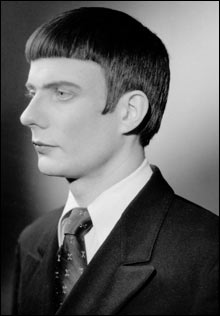
RECOMBINANT: “I hardly in my life came across something completely new — as if it fell out of the sky.” |
For those who heard German electronics maestro Felix Kubin slice the air with fried keyboards and speed-tweaked samples at Boston’s Goethe-Institut last November, his return to the States couldn’t come soon enough. In the meantime, albums were SendSpaced, stories were sought, and Google was searched, but the man remained hard to pin down. Pop deviant? Stone-faced musique concrète mixer? Art-school electronics clown? All of the above?Those questions may be answered this Friday, when the prickly performance artist returns to the Goethe, performing duets with local synth mystics Keith Fullerton Whitman and Jessica Rylan, along with a solo soundtrack to René Clair’s 1924 dadaist film classic, “Entr’acte.” The turn from his previous show’s gnarly pop deconstruction promises a few more clues about one of music’s truly curious souls. He talks about his all-encompassing musical inquisitions via e-mail from his home in Hamburg.
“I don’t like the term ‘eclectic,’ ” he says. “It sounds like arbitrary choices screwed together out of a lack of ideas. In fact, I am very focused when I create something. I am driven, even obsessed, by a certain concept or idea for a work that I create. In a way, I am working more like a conceptual artist than a musician.”
Kubin — born Felix Knoth — made waves in the late ’80s as part of the sheets-of-noise duo Klangkrieg before morphing into the ambiguous “Felix Kubin” entity in 1998. Since then, he’s launched an experimental video and radio-program career (think Gregory Whitehead and Stockhausen) and released some 20 albums, seven-inches, and comps that range from one-off collaborations to erosion-slow solo drones. Perhaps the best received was 2004’s Matki Wandalki (A-Musik), a perfect recap of futuristic adventures sketched out in hyperactive electro-pop colors with warm, blistery synths — likely of the wood-paneled variety. Songs whizzed by at Buck Rogers speed and locked into Raymond Scott melodic engineering precision.
Kubin’s no analog snob, however. He approaches projects scientifically and shows no bias toward lived-in analog gear or convenient digital stuff. “They all have their strengths and weaknesses. Vintage machines have a more intuitive user interface and a warmer, less stable sound or image. They belong to the realm of the illusion. Digital devices can clone everything easily. When I created my first videos [check the new Fernsehpropheten DVD], it was a nightmare to edit. Now, with hard-disk recording, it’s a joke: alt_click_drag. Done.”
For this Friday’s show, he promises some well-considered improvs. To accompany Whitman’s power-synth attack, he plans on utilizing a deep bank of chamber-orchestra rehearsal tapes (“I love these fragile, incomplete recordings very much”). For Rylan, who typically mutilates her own voice and helpless other little audio signals with walls of homemade circuits, he’s considering a more vocal approach. “Maybe a violent lullaby or some cut-up larynx played on an old tape recorder.”
It seems almost unfair that he gets away with this when you consider all the artists who toil for years at any one of these pursuits and whose broader appeal is, shall we say, limited. But, he tells me, “I never liked borders between disciplines. I hardly in my life came across something that looked completely new — as if it fell out of the sky. Most interesting artworks come from recombining æsthetics or ideas in a new way. We get triggered or moved by some artwork or music or thought that makes us mumble, ‘I want to create something like that.’ ”